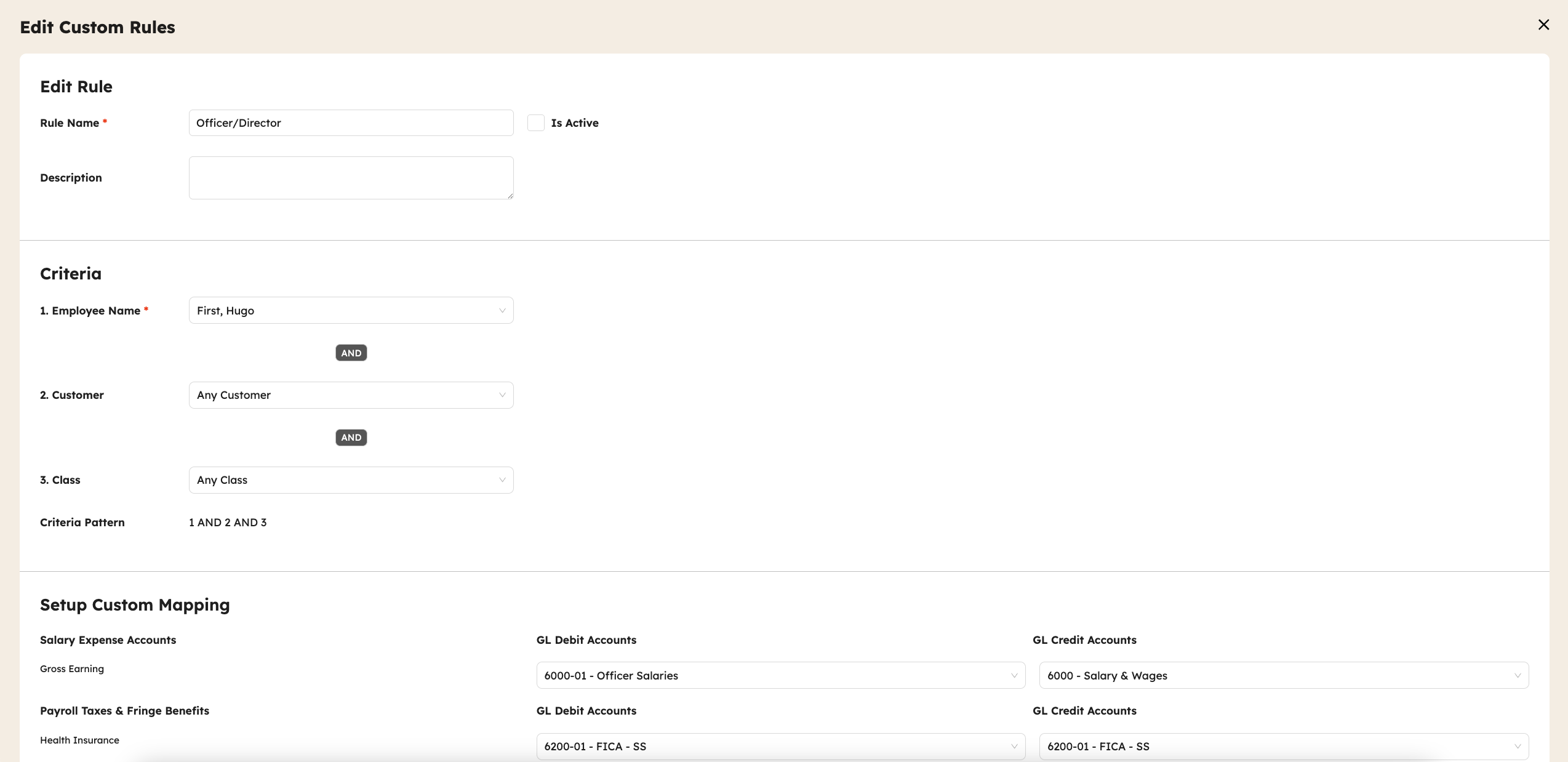Introduction
Custom General Ledger (GL) Mapping Rules in Cost Allocation Pro (CAP) empower users to fine-tune payroll allocations by setting unique criteria for specific employees, customers, and classes. This feature ensures that payroll costs are assigned to the correct GL accounts, streamlining financial reporting and reducing the need for manual adjustments. This guide will explain how to create and configure Custom GL Mapping Rules, with an example illustrating how nonprofits can separate officer salaries.
Accessing Custom GL Mapping Rules
To manage Custom GL Mapping Rules:
- Navigate to the Configurations page in CAP.
- Click the Add Rule button to create a new custom rule.

Step-by-Step Instructions for Creating a Rule
1. Add Rule Details
- On the rule creation screen, enter a meaningful name for the rule, such as Executive Director Salary Mapping.
- Optionally, provide a short description for clarity.
2. Set Criteria
- Choose the specific employee for whom this rule applies by selecting their name (e.g., Executive Director).
- Define additional criteria by specifying the Customer and Class, or leave these as broad criteria (e.g., Any Customer and Any Class).
- This ensures that the rule applies to all of the Executive Director’s time entries.
3. Custom Mapping Section
- Scroll down to the Custom Mapping section.
- Here, you’ll see the default GL mappings (identical to those on the Default Mapping screen in Configurations).
- These mappings include:
- Salaries
- Payroll Taxes and Fringe Benefits
- Other Expenses
- Each category contains subcategories with associated GL debit and credit accounts.
4. Edit Mappings for the Rule
- Adjust the mappings to separate officer salaries:
- In the Salaries category, update the debit account to “Officer Salaries Expense.”
- In the Payroll Taxes and Fringe Benefits categories, update the debit accounts to “Officer Payroll Taxes Expense” and “Officer Fringe Benefits Expense”, respectively.
- Leave the credit accounts unchanged (typically the payroll liability accounts).
5. Save the Rule
- Once all adjustments are made, click Save to finalize the rule.
Example: Separating Executive Director Salaries
Scenario:
A nonprofit organization wants to track the Executive Director’s salary separately from other employees’ salaries. By default, all salaries are mapped to “Salaries - General,” but the Executive Director’s salary must be mapped to “Salaries - Officer Salaries.”
Steps to Set Up the Rule:
1. Name the Rule:
- Enter a name like Executive Director Salary Mapping and include a description, e.g., Custom mapping for the Executive Director’s payroll costs.
2. Set Criteria:
- Select the Executive Director’s name as the Employee.
- For Customer and Class, you can either:
- Set broad criteria (e.g., Any Customer and Any Class).
- Or specify a particular customer and class if the Executive Director’s salary is tied to a specific program or grant.
3. Adjust Custom Mapping:
- In the Salaries category, update the debit account to “Officer Salaries Expense.”
- In the Payroll Taxes and Fringe Benefits categories, update the debit accounts as necessary.
- Keep the credit accounts as they are.
4. Save the Rule:
- Click Save to ensure that the custom mapping is applied to all of the Executive Director’s payroll costs.

Result:
Whenever the Executive Director’s payroll data is allocated, CAP will use the custom GL accounts defined in this rule. The salary, payroll taxes, and fringe benefits will be posted to separate officer-specific expense accounts, making it easier to track and report these costs.
Benefits of Custom GL Mapping Rules
- Precision: Customize payroll allocations for specific employees, customers, or classes.
- Flexibility: Override default mappings without disrupting overall configurations.
- Efficiency: Reduce manual adjustments in QuickBooks Online, saving time during reconciliation.
- Accuracy: Ensure financial reports reflect the true allocation of payroll costs across projects or grants.
Conclusion
Custom GL Mapping Rules in Cost Allocation Pro provide nonprofits with the flexibility to tailor payroll allocations for specific needs, such as separating officer salaries. This feature ensures accurate financial reporting and compliance while reducing manual effort.
Start using Custom GL Mapping Rules today to take full control of your payroll allocations!

